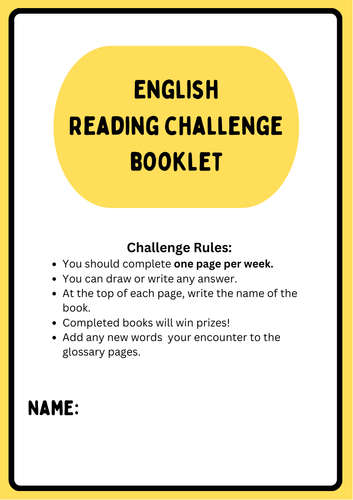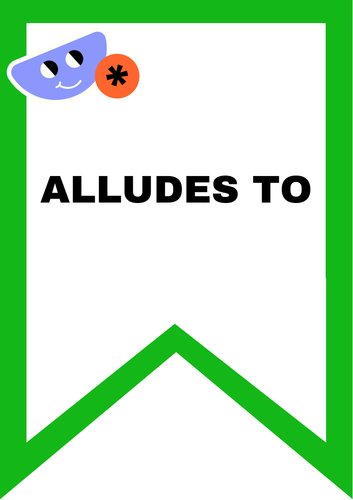12Uploads
3k+Views
2k+Downloads
English

KS3/KS4 Reading Challenge Booklet
16 PAGE BOOKLET, READY TO PRINT OR SHARE. This resource can be used for any text, although it is geared towards fiction texts. I originally designed it for ESL/EAL students but would be relevant for any group who need to develop their comprehension or inference skills.
I have devised a reward system for completed pages and set my students the challenge of completing one page each week, with bonus prizes for finished books or if the entire class completes the weekly challenge.
Research suggests that a rewards-based system is more likely to lead to a positive reading culture and we all know that this leads to increased confidence and, ultimately, better outcomes for our students.
Pages include:
Cause and effect grids
Glossary pages for students to complete for new words
Key themes/messages
Character, setting and plot summaries
Take, enjoy and all the best for improving reading in your classroom!

Bunting: Alternative Words for Suggests
24 WORDS DISPLAYED AS BUNTING, READY TO PRINT.
Brighten up your classroom and your students’ topic sentences with this bunting! Analytical verbs are a key aspect of tier 2 vocabulary that students need to form sophisticated and precise topic sentences. Give your students a hint as well as a positive climate for learning with these rainbow-coloured words.
All you need to add is the string and staples!

MYP Creative Writing Self-Assessment
A self-assessment sheet for criteria C & D that I have used with my classes after a creative writing exercise.
Written in student friendly language, students are encouraged to consider aspects such as characterisation, sentence structure, ‘show not tell’ description and writing with precision.
This resource is easily editable for any writing task but fits particularly well with narratives. This was designed for a class studying the hero’s journey structure, but you could adapt it for any other focus.
I have added two sentence stems encouraging students to state something they are proud of and something they would like to work on. You could easily add something to do with your statement of inquiry or any questions they may have too.

The Handmaid's Tale Chapter 2 LESSON
DETAILED LESSON PLAN AND INTERACTIVE RESOURCE for a lesson teaching students how to approach the structure, style and narrative in Atwood’s ‘The Handmaid’s Tale’.
Students will be encouraged to consider the significance of connotations and denotations of specific word choices and how Atwood uses them to create a specific tone and setting. The lesson follows a ‘shopping’ theme and encourages small group discussion to boost students’ close analysis skills.
The lesson is fully planned with suggestions for differentiation. I have successfully used it as a part of a larger scheme of work for A level and IB Diploma Literature students, but could easily be adapted for Language and Literature.
If you find the lesson helpful, please leave a review to allow others to find it and to let me know that I should make more of these lessons available online!
Bundle

The Handmaid's Tale: FOUR OPENING LESSONS
These are the first four lessons in a unit of work on Atwood’s ‘The Handmaid’s Tale’.
DETAILED LESSON PLANS, SLIDES AND RESOURCES.
Students will be inspired to approach the texts as literary critics, equipped with the knowledge of genre, contextual influences, structural devices and key motifs of the text.
Lesson 1 - Introducing Dystopia
Lesson 2 - Context Research Lesson
Lesson 3 - Focus on the Title, Epigraphs and Chapter Headings as Structural Devices
Lesson 4 - Reading and Analysing Section I Night
The slides are designed to be engaging but not distracting. Each lesson is fully resourced and has an accompanying detailed lesson plan. The activities are varied and include group work, individual paragraph planning, class discussion and post-it reflections.
The teacher lesson plans include key word banks, suggestions of homework/follow up tasks, a bibliography for wider reading and step-by-step activities.
I have taught these lessons successfully with A Level and IB Diploma students across a range of abilities. They are designed to be fully adaptable with a high level of challenge.

Handmaid's Tale Chapter 1 Full Lesson
FULL LESSON PLAN AND SLIDES for chapter one (Night). This lesson is aimed at post-16 students and can be used to introduce students to the key motifs and techniques used in the opening of the novel. The lesson plan details how the activities can be adapted for different abilities and uses a mixture of whole class, partner and individual work.
This lesson works well as a stand-alone class or as a part of a wider unit of work. Students will be introduced to the symbolism, nomenclature, narrative style and tone Atwood introduces at the start of the novel. They will be inspired to begin questioning these aspects and features going forward and will make useful notes that they can revisit later in their study of the novel.
The slides are engaging and the teacher lesson plan (pdf) is clearly presented, including a list of key words and extra pieces of wisdom for the teacher.
This lesson has been successfully taught to both A level and IB diploma students.

Handmaid's Tale Lesson Title & Epigraphs
A ready-to-teach detailed lesson plan and slides on the title, epigraphs and chapter headings in Atwood’s ‘The Handmaid’s Tale’.
This lesson is part of a unit of work aimed at post-16 students studying ‘The Handmaid’s Tale’. This lesson can be taught as a stand-alone lesson and prompts students to consider the elements of the text that they may be tempted to overlook.
Through inquiry questions, partner discussion and individual paragraph planning, you can guide students through the process of analysing and questioning the opening pages of Atwood’s novel. It will also teach them key literary analysis skills that they will then be able to use in the rest of their study of the novel.
The lesson resources include powerpoint slides and a detailed teacher lesson plan. All you need to add are the post-it notes!
If you enjoy this resource, please leave a review to help others find it and let me know if any improvements can be made.

The Handmaid's Tale Context full lesson
Full lesson plan, slides and resource for a research lesson on the literary, political and authorial context of ‘The Handmaid’s Tale’ by Margaret Atwood.
This is the second lesson of a unit aimed at post-16 students, but works well as a stand-alone lesson on the context of the novel.
I have taught this successfully with A level and IB diploma level students. Students will be tasked to work in groups to research key context of the novel. Class discussion slides are provided to prompt reflection on the importance of context and contemporary influence.
Students will end the lesson with a clear idea of the main inspiration for many factors of the novel and will also have notes designed for them to revisit as they work their way through their unit of work. Students will also be prompted to adopt a literary critic’s eye to any relevant news stories or debates that may link to Atwood’s key themes.
Be prepared for an engaging lesson that will inspire learning long after the class time ends!

The Handmaid's Tale Intro to Dystopia
LESSON PLAN, SLIDES AND RESOURCES to help students identify the key components of dystopian literature and introduce them to key terms.
This lesson is primarily aimed at post 16 students, but can be adapted for a mature group of younger students too.
It touches on the importance of preparation for lessons, as well as introducing students to some extracts from key dystopian texts of the 20th century.
This is the first lesson as a part of a scheme I have successfully taught with an A Level Literature class and will also be developing for the IB English A Language and Literature course.
If you find this resource helpful, please leave a review so that others will find it in the future and I can continue to develop and update the unit.

An Inspector Calls: Intro to Context Game
This is a great way to introduce the context of An Inspector Calls (AIC) in a memorable and interactive way.
Complete instructions are provided on the teacher sheet. I recommend displaying a countdown clock on the projector whilst students complete the task and get them to work in teams for an element of competition!
I’ve also added a note for suggested homework or follow up tasks. I’ve used this many times for different texts but this is especially popular for An Inspector Calls with my classes because there is so much for students to remember before reading the first few pages of the text.

Introduction to Persuasive Devices (DAFOREST)
This lesson is intended for an English language class in year 7 (grade 6) or younger. It could be adapted as a revision lesson for older year groups.
It includes an introduction to purpose, audience and text type, as well as basic persuasive devices techniques. When I taught this lesson, I gave out a bag of sweets as a prize for the most persuasive speech at the end of the lesson. Depending on your school reward system, feel free to change the word ‘treat’ to something else, and possibly the image on slide 2 and 5!
I have included a print out for a classroom wide card-sort, which I had the students race to complete in small teams. I hid the terms all around the classroom and the winning team were the first to correctly lay out all the terms on their desk.
I have included clips of famous speeches so students can see how it’s done, although be aware that this may be better suited to cover in a later lesson, depending on the amount of time you have with them. Due to copyright reasons, I couldn’t include any advert pictures on the slides, but there are plenty of examples you could on Google Images use if you’d prefer visuals - Coca Cola have some great ones.
This lessons is designed as a straightforward introduction to persuasive devices but could then be used as a springboard to a unit on speech writing or advertising.

Introductory lesson: Write to Your Future Self
This resource is aimed at year 7, but could be adapted for any year group. I have used it with English classes, PSHE groups, in tutor time and as an induction day task. The main task is to write a letter to their future selves, which I have suggested you time for just before their exams at the end of their school career.
The students will be asked to reflect on the differences between an email and a letter, following a prompt about whether letter writing is a 'lost ’ form of communication. They will reflect on how they have changed and developed since they started primary school (or whenever you choose). They will then consider how they might have changed by the time they read the letter, possibly just before they leave school.
The lesson guides students through the planning and writing processes and includes a recap on letter format.
It’s an excellent way to get to know your students (they will be prompted to write about their likes and dislikes, worries and aspirations, etc.) as well as a chance for students to consider how they might want to spend the next five years of their school career.
In the slides, I have included a link to a website that will automatically email the students on a specific date. Alternatively, you may wish to ask students to write the letters and seal them in envelopes, but obviously be aware of the future commitment this may include!
This is a helpful stand-alone lesson for starting the year or meeting a new class.












